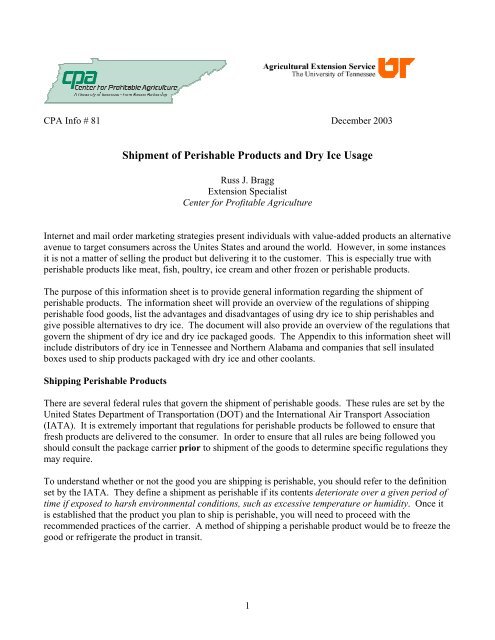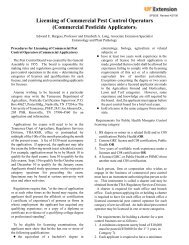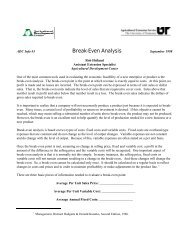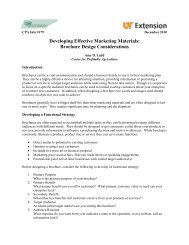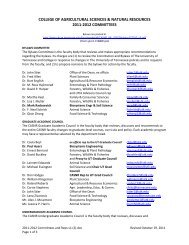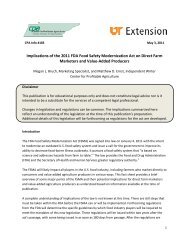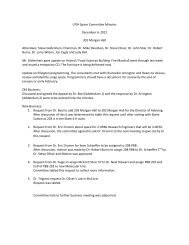Shipping Food Products with Dry Ice - The University of Tennessee ...
Shipping Food Products with Dry Ice - The University of Tennessee ...
Shipping Food Products with Dry Ice - The University of Tennessee ...
Create successful ePaper yourself
Turn your PDF publications into a flip-book with our unique Google optimized e-Paper software.
CPA Info # 81 December 2003<br />
Shipment <strong>of</strong> Perishable <strong>Products</strong> and <strong>Dry</strong> <strong>Ice</strong> Usage<br />
Russ J. Bragg<br />
Extension Specialist<br />
Center for Pr<strong>of</strong>itable Agriculture<br />
Internet and mail order marketing strategies present individuals <strong>with</strong> value-added products an alternative<br />
avenue to target consumers across the Unites States and around the world. However, in some instances<br />
it is not a matter <strong>of</strong> selling the product but delivering it to the customer. This is especially true <strong>with</strong><br />
perishable products like meat, fish, poultry, ice cream and other frozen or perishable products.<br />
<strong>The</strong> purpose <strong>of</strong> this information sheet is to provide general information regarding the shipment <strong>of</strong><br />
perishable products. <strong>The</strong> information sheet will provide an overview <strong>of</strong> the regulations <strong>of</strong> shipping<br />
perishable food goods, list the advantages and disadvantages <strong>of</strong> using dry ice to ship perishables and<br />
give possible alternatives to dry ice. <strong>The</strong> document will also provide an overview <strong>of</strong> the regulations that<br />
govern the shipment <strong>of</strong> dry ice and dry ice packaged goods. <strong>The</strong> Appendix to this information sheet will<br />
include distributors <strong>of</strong> dry ice in <strong>Tennessee</strong> and Northern Alabama and companies that sell insulated<br />
boxes used to ship products packaged <strong>with</strong> dry ice and other coolants.<br />
<strong>Shipping</strong> Perishable <strong>Products</strong><br />
<strong>The</strong>re are several federal rules that govern the shipment <strong>of</strong> perishable goods. <strong>The</strong>se rules are set by the<br />
United States Department <strong>of</strong> Transportation (DOT) and the International Air Transport Association<br />
(IATA). It is extremely important that regulations for perishable products be followed to ensure that<br />
fresh products are delivered to the consumer. In order to ensure that all rules are being followed you<br />
should consult the package carrier prior to shipment <strong>of</strong> the goods to determine specific regulations they<br />
may require.<br />
To understand whether or not the good you are shipping is perishable, you should refer to the definition<br />
set by the IATA. <strong>The</strong>y define a shipment as perishable if its contents deteriorate over a given period <strong>of</strong><br />
time if exposed to harsh environmental conditions, such as excessive temperature or humidity. Once it<br />
is established that the product you plan to ship is perishable, you will need to proceed <strong>with</strong> the<br />
recommended practices <strong>of</strong> the carrier. A method <strong>of</strong> shipping a perishable product would be to freeze the<br />
good or refrigerate the product in transit.<br />
1
<strong>Dry</strong> <strong>Ice</strong> and Alternatives<br />
<strong>Dry</strong> ice is the solid form <strong>of</strong> carbon dioxide and is extremely cold (-109.5°F). However, carbon dioxide<br />
is commonly found in the earth’s atmosphere in its gaseous state. <strong>Dry</strong> ice will change directly from a<br />
solid to a gas at a rate <strong>of</strong> 5-10 pounds per 24 hours in a cooler. One <strong>of</strong> the most beneficial<br />
characteristics <strong>of</strong> dry ice is that it changes from liquid to gas during the thawing process, thus giving it<br />
the name <strong>of</strong> “dry ice.” This is advantageous in comparison to water ice since there is not a liquid state<br />
and will not saturate the package and product <strong>with</strong> water. <strong>The</strong> biggest drawback to using dry ice is the<br />
level <strong>of</strong> regulations that govern its use. Specifically, the rules are based on the hazardous nature <strong>of</strong> dry<br />
ice. <strong>The</strong> potential hazards <strong>of</strong> dry ice during transportation include explosion, suffocation and contact<br />
hazards. However, the risks <strong>with</strong> each <strong>of</strong> these can be addressed <strong>with</strong> proper planning and preparation.<br />
In his 2003 publication, Andy Glode, <strong>with</strong> the <strong>University</strong> <strong>of</strong> New Hampshire, outlined five basic<br />
requirements for shipping <strong>with</strong> dry ice. <strong>The</strong> requirements are presented below:<br />
1. Gas venting: packages must allow for release <strong>of</strong> carbon dioxide gas. <strong>Dry</strong> ice must never be<br />
sealed in a container <strong>with</strong> an airtight seal such as a jar <strong>with</strong> a threaded lid or a plastic cooler.<br />
2. Package integrity: a package containing dry ice must be <strong>of</strong> adequate strength for intended use. It<br />
must be strong enough to <strong>with</strong>stand the loading and unloading normally encountered in transport.<br />
It must also be constructed and closed in order to prevent any loss <strong>of</strong> contents that might be<br />
caused by vibration or by changes in temperature, humidity, or altitude.<br />
3. Package materials: do not use plastics that can be rendered brittle or permeable by the<br />
temperature <strong>of</strong> dry ice. This problem can be avoided by using commercially available packages<br />
intended to contain dry ice.<br />
4. It is possible that the carrier <strong>of</strong> the package will have specific labeling when using dry ice. It is<br />
important to consult the package carrier when you are shipping dry ice to determine their specific<br />
labeling requirements.<br />
5. Labeling: the outermost container must be labeled <strong>with</strong> a hazard class 9 label, UN 1845, and<br />
total weight <strong>of</strong> dry ice in kilograms. (See sample dry ice label that follows) <strong>The</strong> label should be<br />
affixed to a vertical side <strong>of</strong> the box (not the top or bottom) and oriented as in the figure below.<br />
(Glode, 2003)<br />
<strong>Dry</strong> <strong>Ice</strong> Label<br />
2
In some cases, dry ice is made by the shipper <strong>of</strong> the perishable product from liquid CO 2 . <strong>The</strong> resulting<br />
dry ice snow is packed in the top <strong>of</strong> a shipping container <strong>of</strong>fering extended cooling <strong>with</strong>out electrical<br />
refrigeration equipment and connections. When shipping <strong>with</strong> dry ice, it is important to determine the<br />
amount <strong>of</strong> dry ice needed to maintain the desired temperature <strong>of</strong> the product throughout transit. <strong>The</strong><br />
following table will provide a general rule <strong>of</strong> thumb for shipping frozen goods <strong>with</strong> the assistance <strong>of</strong> dry<br />
ice. However, it is recommended that you consult a pr<strong>of</strong>essional dry ice dealer to determine the exact<br />
amount <strong>of</strong> dry ice needed for your shipment.<br />
TABLE OF AVERAGE AMOUNTS OF DRY ICE FOR PACKING FROZEN<br />
GOODS IN A SINGLE CONTAINER<br />
Weight <strong>of</strong><br />
Time In Transit<br />
Frozen<br />
Good<br />
4 Hours 12 Hours 24 Hours 2 Days<br />
2 LB 4 LB 8 LB 16 LB<br />
2 LB <strong>Dry</strong> <strong>Ice</strong> <strong>Dry</strong> <strong>Ice</strong> <strong>Dry</strong> <strong>Ice</strong> <strong>Dry</strong> <strong>Ice</strong><br />
3 LB 6 LB 10 LB 18 LB<br />
5 LB <strong>Dry</strong> <strong>Ice</strong> <strong>Dry</strong> <strong>Ice</strong> <strong>Dry</strong> <strong>Ice</strong> <strong>Dry</strong> <strong>Ice</strong><br />
4 LB 8 LB 14 LB 24 LB<br />
10 LB <strong>Dry</strong> <strong>Ice</strong> <strong>Dry</strong> <strong>Ice</strong> <strong>Dry</strong> <strong>Ice</strong> <strong>Dry</strong> <strong>Ice</strong><br />
5 LB 10 LB 20 LB 30 LB<br />
20 LB <strong>Dry</strong> <strong>Ice</strong> <strong>Dry</strong> <strong>Ice</strong> <strong>Dry</strong> <strong>Ice</strong> <strong>Dry</strong> <strong>Ice</strong><br />
10 LB 20 LB 35 LB 50 LB<br />
50 LB <strong>Dry</strong> <strong>Ice</strong> <strong>Dry</strong> <strong>Ice</strong> <strong>Dry</strong> <strong>Ice</strong> <strong>Dry</strong> <strong>Ice</strong><br />
For each additional day add 8 to 15 pounds.<br />
Source: http://www.dryiceinfo.com/shipping.htm<br />
Since dry ice is extremely regulated by the DOT and IATA, it is sometimes preferred to ship using<br />
alternative cooling products. <strong>The</strong>se products include but are not limited to self-contained gel coolants.<br />
This type <strong>of</strong> product is commonly used in children’s lunch boxes to keep the contents cool. This is an<br />
alternative that is less regulated than dry ice. Other alternatives exist, but it is imperative to consult your<br />
package carrier prior to using them for shipping regulations.<br />
Conclusion and <strong>Dry</strong> <strong>Ice</strong> Suppliers<br />
<strong>Dry</strong> ice is an acceptable coolant to use when shipping perishable products. However, it has several<br />
potential hazards that should be addressed in order to insure safe handling and arrival <strong>of</strong> your perishable<br />
product. Potential limits to using it are the availability <strong>of</strong> dry ice and secure shipping containers. <strong>The</strong><br />
Appendix includes a list <strong>of</strong> dry ice suppliers in <strong>Tennessee</strong> and dry ice container supplier. Before using<br />
dry ice as a coolant when shipping a perishable product, it is important to consult the package carrier<br />
and the dry ice supplier. For further information, the list <strong>of</strong> additional resources and references provides<br />
several websites concerning package carrier’s stipulations and dry ice safety when shipping perishable<br />
products and or using dry ice.<br />
3
Additional Resources and References<br />
<strong>Dry</strong><strong>Ice</strong>Info.com “<strong>The</strong> Worlds Leading source <strong>of</strong> Information about <strong>Dry</strong> <strong>Ice</strong>” http://www.dryiceinfo.com/<br />
Glode, Andy; “UNH Guide to <strong>Shipping</strong> <strong>with</strong> <strong>Dry</strong> <strong>Ice</strong>” <strong>University</strong> <strong>of</strong> New Hampshire<br />
http://www.unh.edu/ehs ; June 9, 2003.<br />
“Packaging Pointers: Perishable Shipment” Federal Express;<br />
http://www.fedex.com/us/services/pdf/PKG_Pointers_Perishable.pdf?link=4<br />
“Perishables – C022.3.2” United States Postal Service;<br />
http://pe.usps.gov/cpim/ftp/manuals/dmm/C022.pdf<br />
4
Appendix<br />
<strong>Dry</strong> <strong>Ice</strong> Suppliers in <strong>Tennessee</strong> and Northern Alabama<br />
Company Name City State Telephone Number<br />
Cope Carbonic Nashville TN 615-255-2011<br />
Continental Carbonic <strong>Products</strong> Nashville TN 615-333-3433<br />
Reddy <strong>Ice</strong> Co. Nashville TN 615-350-8800<br />
Advantage <strong>Dry</strong> <strong>Ice</strong> Hendersonville TN 615-338-4505<br />
Paine Distributor Nashville TN 615-248-2888<br />
Airgas <strong>Dry</strong> <strong>Ice</strong> Memphis TN 901-345-3234<br />
NexAir Memphis TN 901-794-8037<br />
NexAir Memphis TN 901-523-6888<br />
Continental Carbonic <strong>Products</strong> Loudon TN 865-458-7196<br />
Fire Extinguisher Co. Knoxville TN 865-523-7710<br />
Continental Carbonic <strong>Products</strong> Chattanooga TN 423-622-6408<br />
<strong>Dry</strong> <strong>Ice</strong> Sales Chattanooga TN 423-622-6408<br />
East <strong>Tennessee</strong> <strong>Dry</strong> <strong>Ice</strong> Greeneville TN 423-638-1020<br />
C.A.M. INE Huntsville AL 256-534-1008<br />
Shaw <strong>Ice</strong> Co. Athens AL 256-729-1020<br />
Home <strong>Ice</strong> Co. Decatur AL 256-353-4234<br />
Airgas Carbonic Decatur AL 256-355-7095<br />
Reddy <strong>Ice</strong> Co. Huntsville AL 256-533-0214<br />
http://www.dryicedirectory.com/<br />
<strong>Shipping</strong> Container Information<br />
R.N.C. Industries has containers that can be used to ship perishable goods in dry ice through a carrier.<br />
For specific information contact them at the below information:<br />
R.N.C. Industries<br />
Norcross, GA<br />
888-844-3864<br />
FAX 770-368-8490<br />
THE UNIVERSITY OF TENNESSEE, U.S. DEPARTMENT OF AGRICULTURAL AND COUNTY GOVERNMENTS COOPERATING<br />
<strong>The</strong> Agricultural Extension Service <strong>of</strong>fers its programs to all eligible persons regardless <strong>of</strong> race, color, age, national origin, sex, religion, veteran status or disability and is an Equal<br />
Opportunity Employer<br />
5


